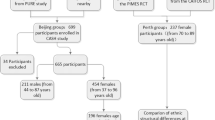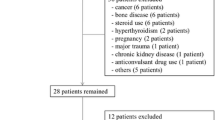Abstract
There are substantial inter-racial differences in hip fracture incidence. Studies in several different ethnic groups have suggested that differences in the length of the femoral neck may contribute to these. The present study assesses femoral neck and hip axis lengths in three ethnic groups in which it has not been documented previously (Chinese, Indians and Polynesians) and compares these values with those in Europeans. Lengths were measured from dual-energy X-ray absorptiometry scans of the proximal femur in normal premenopausal women (n=225). The Polynesian (1.65 m) and European (1.64 m) women were significantly taller than the two Asian groups (mean height in each, 1.58 m). There were also differences in mean body weight, the Polynesians being the heaviest (76 kg) and the Chinese the lightest (53 kg). Femoral neck lengths were (mean + SD) Chinese 61.5+4.4 mm, Indian 61.5+5.1 mm, Polynesian 68.2+4.3 mm and Europeans 66.0+4.8 mm. Hip axis lengths were Chinese 98.0+5.6 mm, Indian 94.5+5.2 mm, Polynesian 106.4 ± 5.3 mm and European 102.3+5.3 mm. Each of the other groups were significantly different from the Europeans for both variables and, in general, this remained so after height adjustment. These data suggest that shorter femoral necks are common to the major Asian racial groups. However, in contrast to all other ethnic groups studied, Polynesians have longer femoral necks than Europeans and their low incidence of hip fracture is not explicable, therefore, in terms of their femoral neck length. This suggests that either higher bone density or other more subtle differences in proximal femoral geometry must account for the low hip fracture incidence in Polynesians.
Similar content being viewed by others
References
Ho SC, Bacon WE, Harris T, Looker A, Maggi S. Hip fracture rates in Hong Kong and the United States, 1988 through 1989. Am J Public Health 1993; 83:694–7.
Elffors I, Allander E, Kanis JA, Gullberg B, Johnell O, Dequeker J, et al. The variable incidence of hip fracture in southern Europe: the MEDOS Study. Osteoporos Int 1994;4:253–63.
Barber J, Mills H, Horne G, Purdie G, Devane P. The incidence of hip fractures in Maori and non-Maori in New Zealand. NZ Med J 1995;108:367–9.
Norton R, Butler M, Currie R, Lee-Joe T, Campbell AJ, Reid IR, Gray H. Hip fracture incidence among older people in Auckland: a population-based study. NZ Med J 1995;108:426–8.
Bacon WE, Maggi S, Looker A, Harris T, Nair CR, Giaconi J, et al. International comparison of hip fracture rates in 1988-89. Osteoporos Int 1996;6:69–75.
Cummings SR, Nevitt MC, Browner WS, Stone K, Fox KM, Ensrud KE. et al. Risk factors for hip fracture in white women. N Engl J Med 1995;332:767–73.
Faulkner KG, Cummings SR, Black D, Palermo L, Gluer CC, Genant HK. Simple measurement of femoral geometry predicts hip fracture: the Study of Osteoporotic Fractures. J Bone Miner Res 1993;8:1211–7.
Peacock M, Turner CH, Liu G, Manatunga AK, Timmerman L, Johnston CC Jr. Better discrimination of hip fracture using bone density, geometry and architecture. Osteoporos Int 1995;5:167–73.
Boonen S, Koutri R, Dequeker J, Aerssens J, Lowet G, Nijs J, et al. Measurement of femoral geometry in type I and type II osteoporosis: differences in hip axis length consistent with heterogeneity in the pathogenesis of osteoporotic fractures. J Bone Miner Res 1995;10:1908–12.
Cummings SR, Cauley JA, Palermo L, Ross PD, Wasnich RD, Black D, Faulkner KG, for the Study of Osteoporotic Fractures Research Group. Racial differences in hip axis lengths might explain racial differences in rates of hip fracture. Osteoporos Int 1994;4:226–9.
Nakamura T, Turner CH, Yoshikawa T, Slemenda CW, Peacock M, Burr DB, et al. Do variations in hip geometry explain differences in hip fracture risk between Japanese and White Americans? J Bone Miner Res 1994;9:1071–6.
Villa ML, Marcus R, Delay RR, Kelsey JL. Factors contributing to skeletal health of postmenopausal Mexican-American women. J Bone Miner Res 1995;10:1233–42.
Mikhail MB, Vaswani AN, Aloia JF. Racial differences in femoral dimensions and their relation to hip fracture. Osteoporos Int 1996;6:22–4.
Cundy TF, Cornish J, Evans MC, Gamble G, Stapleton J, Reid IR. Sources of interracial variation in bone mineral density. J Bone Miner Res 1995;10:368–73.
Reid IR, Chin K, Evans MC, Jones JG. Relation between increase of hip axis in older women in 1950s and 1990s and increase in age specific rates of hip fracture. BMJ 1994;309:508–9.
Stott S, Gray DH. The incidence of femoral neck fracture in New Zealand. NZ Med J 1980;91:6–9.
Reid IR, Mackie M, Ibbertson HK. Bone mineral content in Polynesian and white New Zealand women. BMJ 1986;292:1547–8.
Reid IR, Cullen S, Schooler BA, Livingston NE, Evans MC. Calcitropic hormone levels in Polynesians: evidence against their role in inter-racial differences in bone mass. J Clin Endocrinol Metab 1990;70:1452–6.
Lau EMC. Hip fracture in Asia: trends, risk factors and prevention. In: Christiansen C, Riis B, editors. Osteoporosis proceedings 1993. Fourth international symposium on osteoporosis, Rodovre, 1993:58–61.
O'Neill TW, Grazio S, Spector TD, Silman AJ. Geometric mesurements of the proximal femur in UK women: secular increase between the late 1950s and early 1960s. Osteoporos Int 1996;6:136–40.
Reid IR, Chin K, Evans MC, Cundy T. Longer femoral necks in the young: a predictor of further increases in hip fracture incidence? NZ Med J 1996; 108:20–1.
Author information
Authors and Affiliations
Rights and permissions
About this article
Cite this article
Chin, K., Evans, M.C., Cornish, J. et al. Differences in hip axis and femoral neck length in premenopausal women of Polynesian, Asian and European origin. Osteoporosis Int 7, 344–347 (1997). https://doi.org/10.1007/BF01623775
Received:
Accepted:
Issue Date:
DOI: https://doi.org/10.1007/BF01623775




